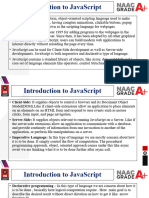0% found this document useful (0 votes)
4 views5 pagesJavascript Into
JavaScript is a high-level programming language essential for web development, enabling dynamic features on web pages. It supports both client-side and server-side development, with key features including being interpreted, weakly typed, and prototype-based. The document also covers JavaScript syntax, comments, variable declaration, naming rules, and data types.
Uploaded by
shafishopeeCopyright
© © All Rights Reserved
We take content rights seriously. If you suspect this is your content, claim it here.
Available Formats
Download as DOCX, PDF, TXT or read online on Scribd
0% found this document useful (0 votes)
4 views5 pagesJavascript Into
JavaScript is a high-level programming language essential for web development, enabling dynamic features on web pages. It supports both client-side and server-side development, with key features including being interpreted, weakly typed, and prototype-based. The document also covers JavaScript syntax, comments, variable declaration, naming rules, and data types.
Uploaded by
shafishopeeCopyright
© © All Rights Reserved
We take content rights seriously. If you suspect this is your content, claim it here.
Available Formats
Download as DOCX, PDF, TXT or read online on Scribd
/ 5




























































































